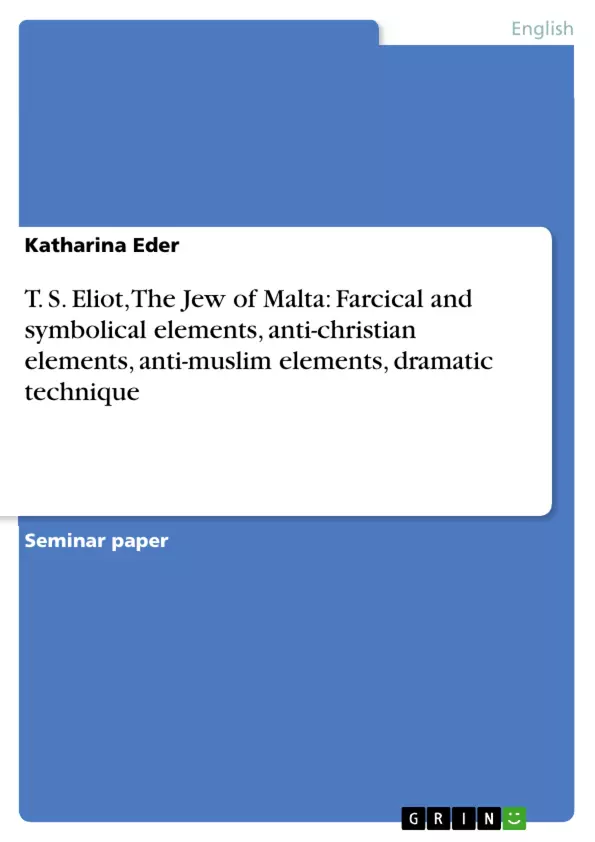The Jew of Malta is often amusing and it would be possible to regard it simply as a brilliant theatrical entertainment intended to make one laugh rather than think. The problem here is to maintain the right balance of the “ludicrous” and the “terrible”. T.S.Eliot was aware of this problem. Even though he preferred to classify the play as a farce rather than as a tragedy, he was careful to emphasise that its humour was “terribly serious”. According to Bawcutt, the Jew of Malta is a harsh and disturbing comedy, near to ridicule, not the cheerful laughter which relaxes and heals. It should not distract one from the play´s seriousness, but intensify it, by making us aware of the ludicrous instability of our attitudes and the absurdity of our pretensions to moral superiority. The play may seem at times a parody of normal human behaviour; even so, it is the kind of parody that is uncomfortably close to reality. (Bawcutt 1978:36).
Several asides in the main plot of The Jew of Malta assume comic function and devices of double entendre (double meaning) are applied. Several asides are unspoken thoughts of a character or confidentially and silently uttered messages addressed to another character, but most of the asides are examples of dramatic irony, in the way that they reveal the innermost thoughts of the characters in contrast to what they actually say. They may reveal doubledealing and the hypocrisy in this way but sometimes also the true honesty and virtue of a speaker. (cf. Abigail, III.iii). They also may function as a dramatic device to raise suspense, anticipating a forthcoming event, such as for example murder or intrigue. An example of this can be found in II.iii when Barabas is talking to Lodowik: “The diamond that I talk of, ne´er was foiled”. The diamond will be foiled though when he touches it. Another example can be found in Act I.ii, when Barabas and Abigail are preparing for the retrieval of gold and money from their former home, now confiscated by the governor and turned into a nunnery.
Table of Contents
- Farcical elements...
- Symbolical elements
- Gold.....
- Barabas's nose..
- The relationship between Christians and Jews in the Renaissance and Anti-Christian elements in The Jew of Malta
- Anti-Muslim elements in The Jew of Malta...
- Literary representation of Turks” in Renaissance England...
- Characterization of Muslim characters in The Jew of Malta...
- Dramatic technique...
Objectives and Key Themes
This paper examines the different elements of Christopher Marlowe's play "The Jew of Malta", focusing on the play's farcical, symbolical, anti-Christian, and anti-Muslim aspects, as well as its use of dramatic techniques. The paper aims to analyze these elements in relation to their historical context and their relevance to the play's overarching themes.
- The interplay of humor and tragedy in "The Jew of Malta" and its implications for audience engagement
- The use of symbolic elements to explore themes of greed, power, and religion
- The portrayal of Christian and Jewish characters in relation to historical and cultural contexts
- The representation of Turks and other Muslim characters in the play
- The application of dramatic techniques such as asides, double entendre, and dramatic irony to enhance the narrative
Chapter Summaries
- This chapter examines the farcical elements of "The Jew of Malta", analyzing how humor is employed to highlight the play's darker themes and to critique social and religious hypocrisy.
- This chapter explores the symbolic elements of "The Jew of Malta", with particular focus on the symbols of gold and Barabas's nose. The chapter analyzes how these symbols contribute to the play's overarching themes.
- This chapter delves into the relationship between Christians and Jews in the Renaissance and examines the anti-Christian elements present in "The Jew of Malta". It discusses the historical context of Jewish persecution and how the play reflects and critiques these issues.
- This chapter explores the anti-Muslim elements in "The Jew of Malta", examining how the play portrays Turks and other Muslim characters. It analyzes the historical and literary context of the representation of Muslims in Renaissance England.
- This chapter investigates the dramatic techniques employed in "The Jew of Malta", including the use of asides, double entendre, and dramatic irony. It analyzes how these techniques contribute to the play's overall impact and engage the audience.
Keywords
The main keywords and focus topics of this paper include: The Jew of Malta, Christopher Marlowe, Renaissance drama, farcical elements, symbolical elements, anti-Christian elements, anti-Muslim elements, dramatic technique, Jewish stereotypes, religious satire, historical context, cultural representation.
- Quote paper
- Bachelor Katharina Eder (Author), 2007, T. S. Eliot, The Jew of Malta: Farcical and symbolical elements, anti-christian elements, anti-muslim elements, dramatic technique, Munich, GRIN Verlag, https://www.grin.com/document/171967



